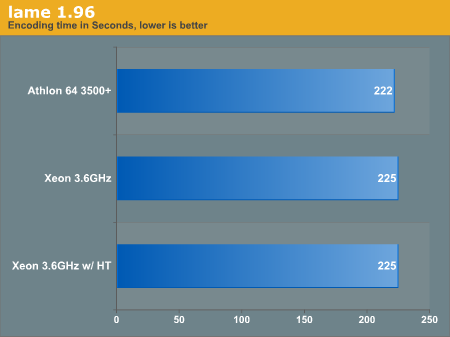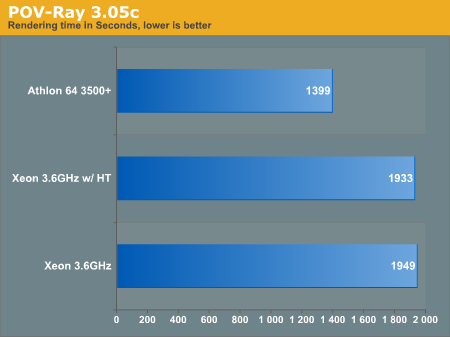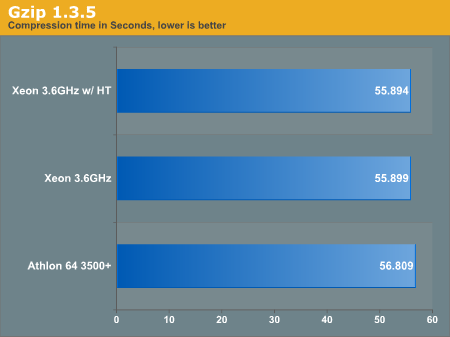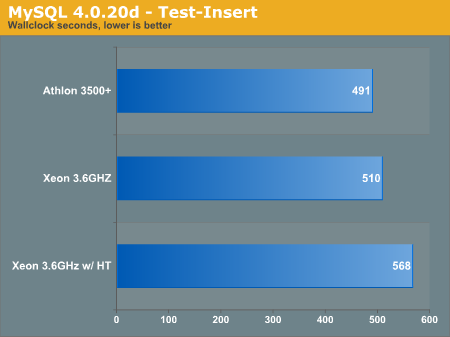Linux and EM64T; Intel's 64-bit Suggestion
by Kristopher Kubicki on August 9, 2004 12:05 AM EST- Posted in
- Linux
Audio Encoding
Lame was compiled from source without optimizations. We only ran ./configure and make, without any flags. We realize that some people would like to verify our binaries and sample files for their own benchmarks. In order to save bandwidth and prevent copyright infractions, we will provide our test files and binaries under limited circumstances to serious inquiries. We ran lame on a 700MB .wav file using the command equivalent to the one below:# lame sample.wav -b 192 -m s -h >/dev/null
Encoding time, lower is better.

POV-RAY
Although POV-RAY is limited in application (particularly when compared against Mental Ray), it does provide a free open source solution for basic rendering. POV-Ray 3.50c was our choice of render engine for this benchmark. For benchmark specifics, we run the exact benchmark as specified by the POV-Ray official site. We use the precompiled RPM for this test.Render Time in Seconds, less is better.

POV-Ray does not have multithread support, so we were not surprised to see the HyperThreading configuration slowing down to the configuration without HT. We see the Athlon 64 processor pull way ahead; render tasks are extremely CPU and memory dependant. With the memory controller on the CPU, Athlon 64 becomes the stronger offering in this situation.
GZip
To throw in some rudimentary tests for GZip, we used the included GZip 1.3.5 to compress the .wav file from the benchmark above. We do not want to limit our I/O on writing to the hard drive, so the operation is performed as below:# time gzip -c sample.wav > /dev/null

Intel wins their first bout of the analysis, albeit not by much. We will find a recurring pattern later on with integer based calculations and the Nocona Xeon processor. The entire Prescott family of Intel CPUs received a dedicated integer multiplier rather than continually using the floating point multiplier. This becomes extremely useful in some of our other benchmarks.
Database Performance
We will run the standard SQL-bench suite included with RPM MySQL 4.0.20d.

Of all our benchmarks, the SQL-bench becomes the most baffling. The extremely threaded database application performs particularly poorly with HyperThreading enabled. The Althon 64 outperforms Intel again in this benchmark, and a lot of it is almost certainly accredited to the on die memory controller again.
Update: We copied the 32-bit marks from our benchmark in previous testing instead of the 64-bit. You can view the previous articles here from a month ago. The graphs have also been updated.










275 Comments
View All Comments
TauCeti - Monday, August 9, 2004 - link
Hi Kristopher,the most disturbing thing for me about your comparisons is your selection of the benchmarks you did run. Some of them are simply not suited at all to run on modern 64-bit systems.
Some details:
Super-Pi:
If you did not get some 'special' version, you benched Super-PI 2.0 compiled with an ancient (GNU) 2.95.2 in late 1999. Purely 32-bit and the compiler blatantly unaware of modern microarchitectures.
TSCP 1.8.1:
You are joking. The TSCP-bench function does need way below 1Megabyte of memory in 32-bit. Totally in-Cache for the Xeon. Did you have a look at the source (it's small enough)? Why did you think that 64-bit could possibly increase performance? That uneccessarily increased mem-consumption and decreased performance.
BTW: TSCP scores about 420000 on my P4(3.0/875) and about 240000 on a Athlon XP2000+ in 32 bit. The latter value is included in the source code.
Tau
thatsright - Monday, August 9, 2004 - link
WOW!!It is just absolutely mind boggling that AnandTech would run such a incompetent article. To compare a High end server chip, to a mainstream desktop chip, is utterly pointless. (And I am a proud owner of a P4c, not a hardcore AMD fanboi.) I would only expect this sort of incomplete and shoddy journalism from Tom's Hardware or the like.
This article should be pulled until a apt and completer comparison can be run with a Opteron chip. I'm getting a bit concerned with the writing of the last few stories here @ AnandTech.
Pjotr - Monday, August 9, 2004 - link
"Relax, its just a primer for future articles. A 3.6F is supposed to compare with a "3600+" rated Athlon 64 isnt it?"No, it's not. They come from two separate market segments. The 3500+ is a desktop CPU. Opteron is AMDs server CPU. Server CPUs typically has more L2 than desktop CPUs, both for Intel and AMD. Also, the 3500+ rating is supposed to compare to Intel desktop CPUs, not server CPUs.
mrdoubleb - Monday, August 9, 2004 - link
OFFSorry for the double post. The 1st one had some typos and I used the BACK button to correct them. Bad idea. :))
mrdoubleb - Monday, August 9, 2004 - link
Now, come on! Honestly, this was meant to be posted on April 1st, wasn't it?! Even in your own previous tests we see that (except for video encoding and a few synthetic tests) the 3500+ beats Prescott 3.6. Is a "Prescott B" coming out so shortly that we don't know of that you claim that the new Nocona 3.6 is exactly like the Prescott 3.6?! Why didn't you put up a similarly priced Opteron against this iAMD64 zombie?!My suggestion for a future test: Sempron 2000+ vs. Prescott 3.6. Title of review: "Both AMD and Intel have released 2 new processors recently. How do they perform against each other?".
mrdoubleb - Monday, August 9, 2004 - link
Now, come on! Honestly, this was meant to be posted on April 1st, wasn't it?! Even in your own previous tests we see that (except for video encoding and a few synthetic tests" we see that the 3500+ beats Prescott 3.6. Is a "Prescott B" coming out so shortly that we don't know fo that you claim that the new Nocona 3.6 is exactly like the Prescott 3.6?! Why didn't you put up a similarly priced Opteron against this iAMD64 zombie?!My suggestion for a future test: Sempron 2000+ vs. Prescott 3.6. Title of review: "Both AMD and Intel have released 2 new processors recently. How do they perform against each other?".
Carfax - Monday, August 9, 2004 - link
To Locutus4657, apparently he used 32bit scores for the first MySQL benchmark on the 3500+ instead of 64bit scores..Had he used 64bit, the 3500+ would have won both benches instead of just one..
Locutus4657 - Monday, August 9, 2004 - link
Here's what I really don't get... Reviewing previous Prescott v. Northwood v. A64 server benchmarks the Prescott was trounced, not only by the A64 but by the Northwood as well (on Mysql Linux). So how the hell did a Prescott end up improving this much in mysql? Were there some core updates I'm not aware of?Fr0zeN2 - Monday, August 9, 2004 - link
Synthetic benchmarks are worthless. Show me some real numbers! I dont care who wins i just want to see real benchmarks!snorre - Monday, August 9, 2004 - link
KristopherKubicki: Don't be stupid, you should always compare with the best possible alternative and in single processor systems that is AMD's Opteron 150 or Athlon 64 FX-53. And besides, AMD's rating has nothing to do with Intel's MHz...